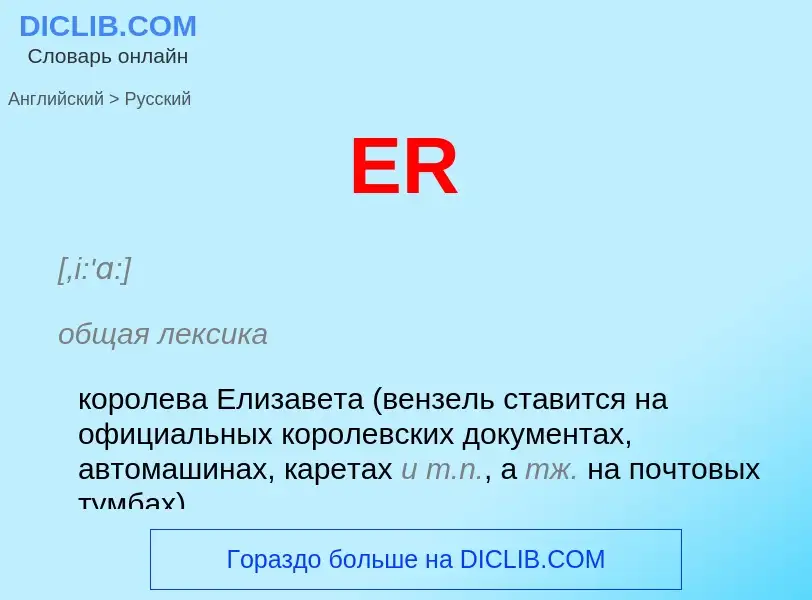Перевод и анализ слов искусственным интеллектом ChatGPT
На этой странице Вы можете получить подробный анализ слова или словосочетания, произведенный с помощью лучшей на сегодняшний день технологии искусственного интеллекта:
- как употребляется слово
- частота употребления
- используется оно чаще в устной или письменной речи
- варианты перевода слова
- примеры употребления (несколько фраз с переводом)
- этимология
knead -er - перевод на русский
[,i:'ɑ:]
общая лексика
королева Елизавета (вензель ставится на официальных королевских документах, автомашинах, каретах и т.п., а тж. на почтовых тумбах)
от лат. Elisabeth Regina
медицина
эндоплазматическая сеть
рецептор эстрогенов
сокращение
[emergency recovery] аварийное восстановление (работоспособности)
[enhanced recovery] добыча нефти с воздействием на пласт (для повышения нефтеотдачи)
[established reliability] установленная надёжность
существительное
общая лексика
пункт первой помощи
синоним
[-ə]
суффикс
[-ə]
общая лексика
образует форму сравнительной степени
односложных и некоторых двусложных прилагательных: colder
warmer
busier
cleverer
narrower
односложных наречий, а также наречия early: faster
harder
earlier
образует существительные от глагольных (baker пекарь) и именных (hatter шляпник) основ, а также сложнопроизводные существительные со вторым компонентом либо в виде основы глагола (loudspeaker громкоговоритель)
либо в виде основы существительного (backbencher «заднескамеечник»
рядовой член парламента)
слова с суффиксом -er имеют значение
человек по роду занятий или профессии
человек по обычному поведению
привычкам
человек
делающий что-л. (постоянно или в данное время)
делающий что-л. в данное время или в какой-л. момент времени
человек таких-то взглядов
участник такого-то движения
человек по общественному положению
возрасту
месту рождения или проживания
машина
устройство со специальной функцией
конкретный предмет
редкое выражение
отдельное действие или абстракция
животное
общая лексика
гранулярная эндоплазматическая сеть
медицина
зернистая эндоплазматическая сеть
Определение
Википедия

In cooking (and more specifically baking), kneading is a process in the making of bread or dough, used to mix the ingredients and add strength to the final product. Its importance lies in the mixing of flour with water; when these two ingredients are combined and kneaded, the gliadin and glutenin proteins in the flour expand and form strands of gluten, which gives bread its texture. (To aid gluten production, many recipes use bread flour, which is higher in protein than all-purpose flour.) The kneading process warms and stretches these gluten strands, eventually creating a springy and elastic dough. If bread dough is not kneaded enough, it will not be able to hold the tiny pockets of gas (carbon dioxide) created by the leavening agent (such as yeast or baking powder), and will collapse, leaving a heavy and dense loaf.
Kneading can be performed by hand (the traditional way), with a mixer equipped with a dough hook, or with a bread machine. In hand kneading, the dough is put on a floured surface, pressed and stretched with the heel of the hand, folded over, and rotated through 90° repeatedly. This process continues until the dough is elastic and smooth. The dough can then be allowed to rise or "prove".
Similar to kneading is knocking back or punching down, which is done to the dough after proving. The dough is punched once or twice, after which it is kneaded gently for a short time. The aim of this is to remove any large gas pockets which have formed in the dough, create an even texture in the bread, and redistribute the nutrients for the yeast, thus allowing fermentation to continue. The dough can then be proofed a second time. Another method of knocking back (also known as "folding") is to gently stretch and pat out the proved dough before folding the sides in towards the centre.
In bread baking, kneading can be substituted by allowing a relatively wet, low-yeast dough to rise for more than 12 hours; this method is referred to as no-knead bread.




![[[Skeletal muscle]] fiber, with sarcoplasmic reticulum colored in blue. [[Skeletal muscle]] fiber, with sarcoplasmic reticulum colored in blue.](https://commons.wikimedia.org/wiki/Special:FilePath/Blausen 0801 SkeletalMuscle.png?width=200)

![nucleus]] (shown in the lower right-hand area of the picture). Dark small circles in the network are [[mitochondria]]. nucleus]] (shown in the lower right-hand area of the picture). Dark small circles in the network are [[mitochondria]].](https://commons.wikimedia.org/wiki/Special:FilePath/Clara cell lung - TEM.jpg?width=200)
